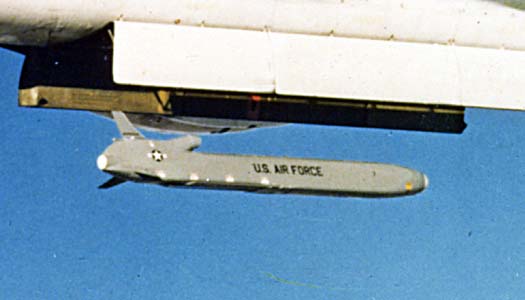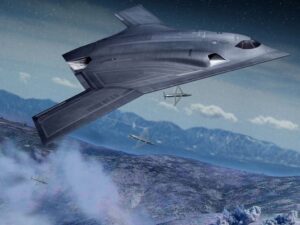By Blake McMahon

Air-Launched Cruise Missile (ALCM)
Tuesday, Northrop Grumman won the contract to develop the Air Force’s next strategic bomber. Specifics about the competing designs have remained a closely-guarded secret, and the exact capabilities of the new aircraft are likely to remain classified for some time. One fact that is already known about the new bomber, however, is that, like the B-52 and the B-2 before it, it will be designed to be “dual-use,” meaning that it will be able to carry either conventional or nuclear weapons as required. Dual-use is a critical — but controversial — capability.
The Air Force is also considering whether or not to pursue a new air-launched cruise missile (ALCM). The new ALCM – known in defense circles as the long-range standoff (LRSO) weapon – would possess advanced capabilities to increase the chances of success and against modern air defenses. Like the new bombers that may one day employ it, this missile is dual-use as well.

Northrop Grumman Long Range Strike Bomber (LRSB)
The most obvious benefit: The ability to carry both nuclear and conventional payloads provides a key economic advantage during a period of tight budgets. With dual-use capabilities, there is no need to develop both nuclear weapon systems and conventional ones; the two are combined in the same basic package. Training and logistics pipelines can be simplified, operations unified.
Yet skeptics argue that the adoption of dual-use capabilities will endanger strategic stability, and is therefore dangerous. The most common form of this argument revolves around the supposed “misidentification problem”: If weapon systems are dual-use, an adversary may mistake an incoming conventional attack for a nuclear strike. According to these skeptics, such misperceptions could lead a nuclear-armed adversary to escalate by accident.
There are a few historical and conceptual issues with this line of thinking. From a historical perspective, dual-use platforms are not new. In the past they have included artillery; land- and sea-based fighter aircraft; strategic bombers; surface vessels; submarines; as well as short, intermediate, and long range missiles. Today, aircraft and ALCMs remain the only dual-use platforms in the US arsenal (adversaries may have more options).
Why then, was strategic stability among nuclear adversaries maintained during periods in which dual-use capabilities were much more common?
The answer to this question is a conceptual one that is derived from the grim logic of deterrence. Nuclear deterrence depends on the logic of secure second strike. Maintaining the ability to retaliate is the key driver of stability, since it is the expectation of a costly response that prevents opponents from attacking in the first place. Consequently, the most destabilizing capabilities are those which could largely or completely wipe out an opponent’s retaliatory forces.
It is unclear why one would expect weapon systems like ALCMs and bombers to be particularly destabilizing. For these new dual-use capabilities to disrupt the deterrence calculus that creates strategic stability, one would have to argue that these weapon systems would fundamentally change our ability to threaten a critical mass of our adversary’s retaliatory forces. But dual-use bombers are not good first-strike systems, because they take longer to reach their targets than ballistic missiles. On the deterrent side, by multiplying the number of platforms that could deliver the second strike, we make it harder for an enemy to wipe out our retaliatory force, which makes it less likely for them to gamble on a first strike in the first place.
It is not so much a specific capability that threatens an adversary’s ability to retaliate, but rather the way in which capabilities are used. A conventional strike from a bomber or ALCM would not itself threaten strategic stability for the same reason why US artillery strikes against Communist targets in Vietnam did not: These dual-use capabilities were employed in a way that did not threaten the retaliatory capability of our nuclear adversaries.
Of course, there are two sides to the strategic stability coin. If the ability of opponents to retaliate following a first strike is crucial for preserving peace, then the United States must also maintain this capability.
The defenses that would protect enemy targets against a second strike by the United States are becoming harder to defeat. The type of modern air defenses cited by Secretary of Defense Ash Carter in Tuesday’s announcement — like the Russian-built S-400 system — can reportedly target the re-entry vehicles from ballistic missiles coming through the atmosphere. These anti-access systems likely pose even greater threat to the survivability of the aircraft and cruise missiles already in the United States’ inventory. It is this threat to our current, aging bomber force that drove the Long-Range Strike Bomber project from the beginning.
This underscores the biggest threat to strategic stability: an enemy that no longer fears our retaliatory capability. The new bomber and ALCM are 21st century platforms designed to contend with 21st century countermeasures. It is these capabilities that will help to guarantee strategic stability and peace into the future.
Dr. Russell “Blake” McMahon is a research professor at the Air Force Research Institute at Maxwell Air Force Base, Alabama. The views expressed in this article are those of the author and do not reflect the official policy or position of the United States Air Force, Defense Department, or the US Government.
Air Force picks Anduril, General Atomics for next round of CCA work
The two vendors emerged successful from an original pool of five and are expected to carry their drone designs through a prototyping phase that will build and test aircraft.


























